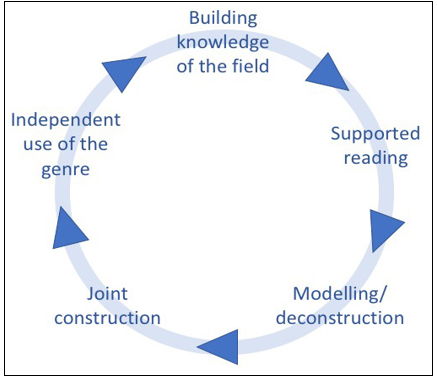Overview
The Teaching and Learning Cycle (Derewianka & Jones, 2016) is a model for integrating the English language modes, and for integrating literacy with subject knowledge (Victorian Curriculum and Assessment Authority (VCAA), 2017,
Victorian Curriculum Foundation-10: English) and (Victorian Curriculum and Assessment Authority (VCAA), 2020, Victorian Curriculum Foundation-10:
English as an Additional Language (EAL)).
Derewianka and Jones describe the teaching and learning cycle as involving:
- an initial focus on engaging students in the topic, eliciting prior knowledge, and building shared understandings about the topic.
- modelling the genre, discussing the social purpose of this form of writing, the structure of the genre and some of its key language features.
- guided reading of an example of the genre, which also continues to build students' understanding of subject knowledge.
- a process of gathering information about the topic where students locate, summarise, categorise and represent the information they have gathered, and participate in a joint construction of a text.
- a similar gathering information phase where students independently research a similar topic and write their own texts.

Adapted from Derewianka, B. & Jones, P. (2016). Teaching Language In Context (2nd ed.). South Melbourne, Victoria: Oxford University Press.
Example of the structure
The Teaching and Learning Cycle is usually taught over an extended period of time. Example lesson sequences for the teaching of writing through the cycle are available, as is an example of the cycle used in the daily structure of literacy in the classroom.
The example provided here addresses how a teacher may begin an inquiry unit of work, commencing with Building the Field and Supported Reading, providing students with opportunities to read and write about their initial investigations. The early drafting phase allows students to use new content and language knowledge to write notes, draw labelled diagrams, or to write a more extended text based on topic focus.
The complete cycle of Building the Field, including Supported Reading, Modelling or Deconstruction, Joint Construction and Independent Construction could involve excursions, incursions, visiting speakers, experiments, reading and viewing multiple texts and multiple opportunities for writing.
Context
The Teaching and Learning Cycle is a highly scaffolded approach to teaching literacy in Foundation to Year 2. The teacher moves students through each phase of the cycle, providing support for them to listen, speak, read and write, whilst simultaneously building deep content knowledge (Spycher, 2017). Teachers could elect to use this approach as an extended focus on writing across a school term.
Teachers may choose to use The Teaching and Learning Cycle to assist students to learn to write in a specific genre within a subject area (such as an information report in Science, a narrative in History, a procedure in Health and Physical Education). Through this staged approach to teaching writing, teachers assist students to closely analyse how the structure and language features of the focus genre assist them to achieve the purpose of a text (Christie, 2005).
Teachers may also use The Teaching and Learning Cycle to create a clear, logical and meaning-focused approach to teaching writing to EAL students (Miller, 2007). The intention to simultaneously build understanding of content and language, to maximise learning through shared experiences, and to guide students through staged, scaffolded activities is highly beneficial for EAL learners (Gibbons, 2015).
Purpose
The Teaching and Learning Cycle incorporates high impact teaching strategies
(HITS). Among these, there is emphasis on explicit teaching; differentiated teaching; multiple exposures to text and content; modelled/worked examples, and questioning. Each phase of the cycle allows the teacher to provide a
gradual release of responsibility (Vygotsky, 1986).
This intentional focus on scaffolding students through the different phases of the cycle allows teachers to develop students' writing skills
in context (Derewianka, 1990) and
over time. With a particular purpose and audience in mind, students build their understanding of academic language, they read texts related to the topic of inquiry or investigation, and they draw on modelled and jointly constructed texts to create a text that conforms to the structure and language features of the focus
genre.
Recommendations
In implementing The Teaching and Learning Cycle approach, it is recommended that teachers:
- return to the phase of 'Building the Field' of knowledge and language throughout a unit of work (Derewianka & Jones, 2016).
- provide regular opportunities for students to write throughout each phase, so that they slowly build up to writing an extended text.
- use 'message abundancy' (Gibbons, 2015), whereby key ideas are presented in a multitude of ways (visuals, printed and digital texts, the use of word walls, charts, aural and tactile resources, hands-on activities, physical movement and gesture, written notes and illustrations, spoken language accompanied by action; excursions/incursions).
- incorporate differentiated, guided and/or independent reading and research that involves multiple readings of texts to locate, analyse, summarise and represent new information (Derewianka & Jones, 2016).
- provide opportunities for learning vocabulary in context (Cummins, 2008).
- explicitly teach English grammar in context at word, sentence and text level (Christie, 2005; Derewianka, 1990; Gibbons, 2015).
References
Christie, F. (2005).
Language education in the primary years. Sydney, Australia: UNSW Press.
Derewianka, B. (1990).
Exploring How Texts Work. Sydney: PETA.
Derewianka, B. & Jones, P. (2016).
Teaching Language In Context (2nd ed.). South Melbourne, Victoria: Oxford University Press.
Gibbons, P. (2015).
Scaffolding language, scaffolding learning: Teaching second language learners in the mainstream classroom (2nd ed.). Portsmouth NH: Heinemann.
Miller, J. (2007), Diving into Everyday Texts: From Comprehension to Production.
Practically Primary, 12.2, pp. 26–31.
Spycher, P. (2017).
Scaffolding writing through the "teaching and learning cycle." San Francisco, CA: WestEd.
Victorian Curriculum and Assessment Authority (VCAA) (2017).
Victorian Curriculum Foundation-10: English. Retrieved from
https://victoriancurriculum.vcaa.vic.edu.au/english/english/curriculum/f-10
Victorian Curriculum and Assessment Authority (VCAA) (2020).
Victorian Curriculum Foundation-10: English as an Additional Language [EAL] https://victoriancurriculum.vcaa.vic.edu.au/english/english-as-an-additional-language-eal/introduction/rationale-and-aims
Vygotsky, L. S. (1986).
Thought and Language. Cambridge, MA: MIT Press.